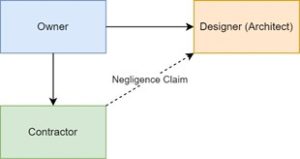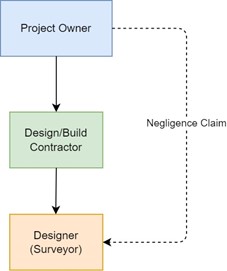In both Donnelly v. Oberg/Hunt/Gilleland and Cal-Am v. Edais Engineering, a third-party claimant brought negligence claims against a design professional for purely economic harm. In each case, the claimant lacked contractual privity with the designer. However, in one case, the lack of contractual privity proved fatal, while in the other case it did not. What explains the different outcomes?
The answer appears to hinge on: (1) who hired the design professional and (2) the claimant’s identity. In Donnelly, the project owner hired the designer, and the claimant was the general contractor (also hired by the owner):
The court determined the lack of contractual privity between the design professional and the general contractor did not preclude a duty of care because it was foreseeable the contractor would be harmed by the designer’s negligence.
By contrast, in Cal-Am, the design/build contractor hired the design professional, while the claimant was the project owner:
In this context, the court determined the designer did not owe a duty of care to the owner because they had no special relationship with each other. Unlike in Donnelly, the court emphasized that the designer was contracted by the design/builder to provide a design that would be relied upon by the design/builder, not the owner.
In short, where the claimant was required to rely on the designer, their lack of contractual privity did not matter. However, where the claimant did not rely on the designer, the lack of privity proved fatal to the claim.


